Environment
All pigs should live in a suitable and comfortable environment. A pig’s home affects how a pig feels, thinks and behaves. Providing your pig with shelter and a comfortable resting area is one way you can make sure that your pig stays healthy and happy.

Did you know that there is a special law protecting animals?
This law is called the Animal Welfare Act. The Animal Welfare Act outlines how people must take care of and act towards animals in New Zealand. The Ministry for Primary Industries (MPI), the Police and SPCA work together to make sure people in New Zealand follow these laws.
Under the Animal Welfare Act, all animal guardians (owners) are responsible for making sure the welfare needs of animals in their care are met. Learning about the Five Domains helps us to understand these welfare needs and how we can make sure we provide these. One of the Five Domains is Environment. In this section you will learn about this domain and how you can make sure your pigs have the right environment, shelter, bedding, etc. they need for positive welfare.





















.jpg) If your pig will be living outside, you will need to make sure their housing area is safe and secure from either them being able to escape or from other animals coming into their environment.
If your pig will be living outside, you will need to make sure their housing area is safe and secure from either them being able to escape or from other animals coming into their environment.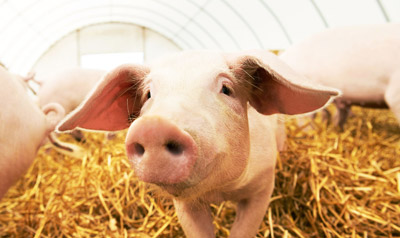 All pigs need a weatherproof, well-ventilated, comfortable shelter to feel safe and secure in. This might be a shed, or barn or even an arc. Your pig's shelter should keep out the rain and the wind, keeping your pig warm and dry inside. It is also important that their arc is in a sheltered area and not placed directly into the wind.
All pigs need a weatherproof, well-ventilated, comfortable shelter to feel safe and secure in. This might be a shed, or barn or even an arc. Your pig's shelter should keep out the rain and the wind, keeping your pig warm and dry inside. It is also important that their arc is in a sheltered area and not placed directly into the wind.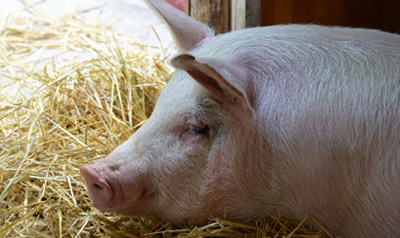 Inside your pig's shelter, they also need bedding to help keep them warm and dry. Otherwise, it would be like you sleeping without blankets in winter - brrrrrr! Pigs also love to build nests, so the best way to provide for both comfortable, warm bedding and being able to make a good, deep nest, is to provide material for your pig to use. For this, you should use clean, dry straw or hay.
Inside your pig's shelter, they also need bedding to help keep them warm and dry. Otherwise, it would be like you sleeping without blankets in winter - brrrrrr! Pigs also love to build nests, so the best way to provide for both comfortable, warm bedding and being able to make a good, deep nest, is to provide material for your pig to use. For this, you should use clean, dry straw or hay. Depending on whether your pig lives in a barn, where the floor might be earthen, or whether they sleep in an arc outside with a wooden floor, the flooring of your pig’s shelter should be sturdy and stable, as pigs like to feel their hoofs are firmly on the ground at all times.
Depending on whether your pig lives in a barn, where the floor might be earthen, or whether they sleep in an arc outside with a wooden floor, the flooring of your pig’s shelter should be sturdy and stable, as pigs like to feel their hoofs are firmly on the ground at all times.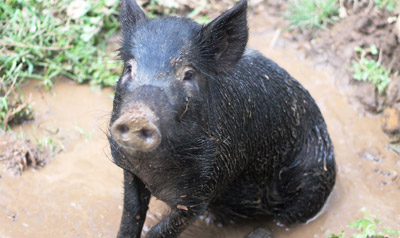 An interesting fact is that pigs are not able to cool down by sweating – like we can – therefore it is very important that they are able to keep cool by other means when the weather is warm. To protect your pig from the sun, and hot temperatures, you should provide shade for their environment outside. This can be done with shady trees or hedges or areas covered by shade cloth, or a sheltered area which provides some moving air out of the sun.
An interesting fact is that pigs are not able to cool down by sweating – like we can – therefore it is very important that they are able to keep cool by other means when the weather is warm. To protect your pig from the sun, and hot temperatures, you should provide shade for their environment outside. This can be done with shady trees or hedges or areas covered by shade cloth, or a sheltered area which provides some moving air out of the sun.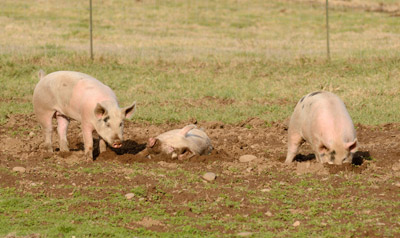 root up the ground, so there should be grass/pasture available to pigs in the area they live in. You can read more about the need of pigs to root up the ground in our
root up the ground, so there should be grass/pasture available to pigs in the area they live in. You can read more about the need of pigs to root up the ground in our 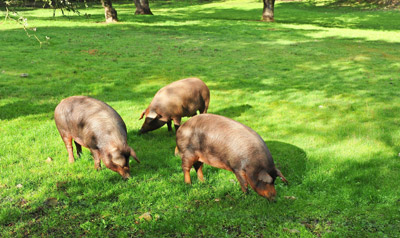 Contrary to popular belief, pigs are not dirty animals. They actually really enjoy being clean and having a large enough area where they can keep their different living areas separate.
Contrary to popular belief, pigs are not dirty animals. They actually really enjoy being clean and having a large enough area where they can keep their different living areas separate.  Pigs are naturally intelligent, playful animals, therefore the more space you can give them, the better off they will be. A pig who does not have a lot of activity throughout the day or is frustrated because of lack of space can become destructive.
Pigs are naturally intelligent, playful animals, therefore the more space you can give them, the better off they will be. A pig who does not have a lot of activity throughout the day or is frustrated because of lack of space can become destructive.








